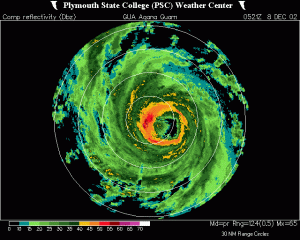Remembering Typhoon Pongsona

It’s been now 8 years since Typhoon Pongsona made landfall on Guam, bringing in with destruction along with $370 million dollars in 2002 US dollars; if adjusted with inflation, it’s $465.4 million USD on 2020 currency.
Pongsona was first noticed by the Japan Meteorological Agency on December 2, 2002, and designated as a tropical depression near Pohnpei. It was later designated by the Joint Typhoon Warning Center as 31W, and will later be upgraded to a tropical storm in the next day, being named Pongsona. Pongsona moved to the west due to a ridge, and became a typhoon on December 5.

Pongsona then continued to intensify until it reached its peak intensity on December 8, with winds of 150 mph with a minimum pressure of 910 millibars. The storm then later made landfall on Guam at 05:00 UTC, and then later, the northern part of the system crossed over Rota. The storm then turned to the north-northwest due to a subtropical ridge near the northern Mariana Islands. Pongsona will later then undergo an eyewall replacement cycle, a cycle that will be completed on December 11, 2002.
Pongsona brought destruction to both Guam and Rota, with extensive damage being seen when Guam was inspected after the storm. The island immediately was declared a “major disaster area”, allowing aid to come in the island. In total, the storm got 1 dead indirectly, and caused $370 million 2002 US dollars in damages; if adjusted with inflation, it’s $465.4 million USD on 2020 currency.

Typhoon Pongsona maintained a 65 km (40 mi) wide eye upon crossing the northern portion of the island of Guam; the Andersen Air Force Base was in the eye for two hours. Sustained winds from the typhoon peaked at 232 km/h (144 mph) with gusts peaking at 278 km/h (173 mph); gusts of at least 160 km/h (100 mph) affected the entire island. The lowest pressure on the island was 935 millibars (27.61 inHg), making Pongsona the third most intense typhoon to strike Guam; it is behind only a typhoon in 1900 (926 mbar, 27.34 inHg) and Typhoon Karen of 1962 (932 mbar, 27.52 inHg).
